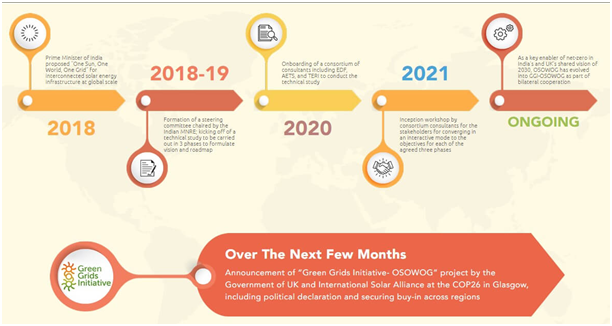

Context
India launched Green Grids Initiative in collaboration with UK last year, there persists some challenges.
This brief aims to analyse the challenges and opportunities in implementing this initiative.
Background
- The COP26 summit held last year, brought parties together to accelerate action towards the goals of the Paris Agreement and the UN Framework Convention on Climate Change (UNFCCC).
- The conference called for participating nations to accelerate their transition from fossil fuels to clean power.
- Based on this PM Modi announced India’s Panchamrit to accelerate the energy transition in India.
- Furthermore, under the International Solar Alliance, India announced the launch of the Green Grids Initiative — One Sun, One World, One Grid (GGI-OSOWOG) in partnership with the United Kingdom.
|
INTERNATIONAL SOLAR ALLAINCE:
|
|
ONE SUN, ONE WORLD, ONE GRID- OSOWOG) About-
|
Evolution of OSOWOG into GGI-OSOWOG
Green Grids Initiative was a program of the United Kindom (UK).
The United Kingdom and India agreed to combine forces of the Green Grids Initiative and the One Sun One World One Grid initiative and jointly launch GGI-OSOWOG at the COP26 summit being hosted by the UK at Glasgow in November 2021.

AIM OF GGI-OSOWOG:
This project aspires to harness the sun’s energy and build a global interconnected electricity grid to accelerate the transition to renewable energy.
The development of the grids will take place in three stages:
- The interconnection of the Indian grids with the Middle East, South Asia and Southeast Asian (MESASEA) grids
- MESASEA grids' interconnection with the African power grid
- Finally, global interconnectivity
The initiative is expected to connect more than 80 countries across a large geographical area, with varying levels of sunlight. A transitional system will enable countries with low levels of sunlight to obtain energy from areas with an excess of it.
BENEFITS OF GGI:
- GGI can transform the traditional energy system by replacing thermal power plants with solar energy, making India more resilient against extreme weather conditions and less dependent on fossil fuels.
- Solar energy will improve the lives of rural people of India by enabling them to carry out activities and improving their standard of living in an environmentally friendly manner.
|
For example: solar-powered agriculture pumps to extract groundwater, which are more environmentally friendly than traditional diesel ones. The number of diesel pumps in India is 10 million. |
- GGI can enhance the quality of life of rural communities in many other areas like access to electronic gadgets, clean drinking water, among others.
- One worldwide grid will provide access to clean energy at all places with reducing the need to store energy, as well as increasing the viability of solar projects.
- India is targeting to generate 40% of power from non-fossil fuels by 2030 which will be boosted by the one sun one grid initiative.
- The proposed integration would lead to a reduction in project costs, higher efficiencies, and increased asset utilization for all the participating entities.
CHALLENGES:
- No clarity or any documentation on improving the efficiency of the existing solar energy infrastructure in the country.
- A majority of the solar energy infrastructure is located in desert regions, which brings dust deposits on panels. A layer of dust decreases solar power conversion efficiency by 40 per cent.
- Environmental costs: Solar energy technologies such as batteries and panels use energy-intensive raw materials and several chemicals and heavy metals that need to be handled and disposed of correctly.
- Waste management: India currently considers solar waste a part of electronic waste and does not account for it separately.
|
The International Renewable Energy Agency (IRENA) last December estimated that the global photovoltaic waste will touch 78 million tonnes by 2050, with India expected to be one of the top five photovoltaic-waste creators. |
Solar panel life:
- Solar panels generally have a lifespan of 25 years, after which they have to be retired since they lose their efficiency.
- According to these trends, it is estimated that 28 million panelswill have to be decommissioned every year, starting 2026.
- Most of these panels will be disposed of in landfills, drawing severe environmental repercussions.
|
What is solar waste?
|
Way Forward
- Reuse and recycle of waste material
- The market value of raw materials recovered from solar panels could reach $450 million by 2030, according to a projection by the International Renewable Energy Agency.
- The value of recoverable materials might surpass $15 billion by 2050, which would be enough to power 630 GW with two billion solar panels.
|
Why are we not recycling more?
|
- India can revise its existing electronic waste management framework to include PV modules and batteries on the lines of extended producer responsibility (EPR).
- Under the extended EPR, developers should report the sale of their products, collect the damaged or discarded products from consumers free of cost, and update the status of their targets.
- A market-driven initiative is important for a thriving waste collection and recycling industry. The various stakeholders of the Indian solar industry should take responsibility to invest in recycling technologies, finance routes, and feasibility examination by pilot projects.
For example:Solar Energy Industries Association (SEIA) in the United States and Japan's New Energy and Industrial Technology Development Organization (NEDO)
Conclusion
As distributed renewable energy sources such as solar PV and energy storage penetrate deep into the Indian electricity sector, it is necessary to prepare for managing the waste generated from these technologies. In addition to being environmentally benign, the 'reduce, reuse, and recover' approach offers multiple socio-economic co-benefits. The local manufacturing industry will benefit from decreased dependence on the import of raw materials. It is imperative for the government to introduce a holistic policy framework for handling the waste from clean energy technologies, highlighting the responsibility of different stakeholders, and creating an enabling environment to implement the same.

